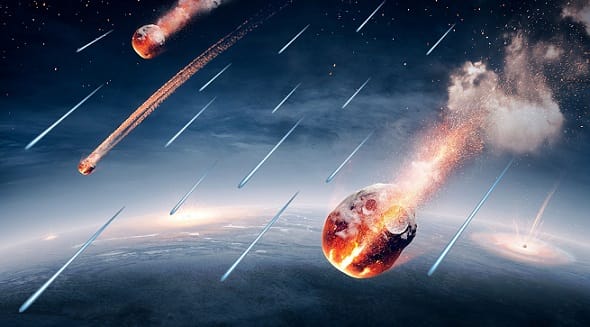In a new paper published today in the journal Astronomy okike, a team of researchers from the UK, Australia and America describe how new analysis of an ancient asteroid suggests that extraterrestrial dust grains carried water to Earth as the planet formed.
The water in the grains was produced by space weathering, a process by which charged particles from the Sun known as solar wind altered the chemical composition of the grains to produce water molecules.
Nchọta a nwere ike ịza ajụjụ dịteworo aka bụ ebe ụwa bara ụbara mmiri na-adịghị ahụkebe nwetara oke osimiri nke na-ekpuchi pasenti 70 nke elu ya - karịa mbara ala okwute ọ bụla ọzọ dị na Sistemụ Anyanwụ anyị. Ọ nwekwara ike inyere ndị ọrụ oghere ga-eme n'ọdịnihu aka ịchọta isi iyi nke mmiri na ụwa enweghị ikuku.
Planetary scientists have puzzled for decades over the source of Earth’s oceans. One theory suggests that one type of water-carrying space rock known as C-type asteroids could have brought water to the planet in the final stages of its formation 4.6 billion years ago.
Iji nwalee tiori ahụ, ndị ọkà mmụta sayensị enyochalarị akara mkpịsị aka isotopic nke chunks nke ụdị C-ụdị asteroids nke dabara n'ụwa dị ka carbonaceous chondrite meteorites nwere mmiri. Ọ bụrụ na oke hydrogen na deuterium dị na mmiri meteorite dabara na nke mmiri terrestrial, ndị ọkà mmụta sayensị nwere ike ikwubi na ụdị meteorites C nwere ike ịbụ isi iyi.
Nsonaazụ apụtachaghị nke ọma. Ọ bụ ezie na akara mkpịsị aka deuterium/hydrogen ụfọdụ meteorites nwere mmiri dabara na mmiri ụwa, ọtụtụ emeghị. Na nkezi, akara mkpịsị aka mmiri mmiri meteorites a adabaghị na mmiri a chọtara n'uwe elu ụwa na oke osimiri. Kama nke ahụ, ụwa nwere akara mkpisiaka isotopic dị iche, dị ntakịrị.
N'ikwu ya n'ụzọ ọzọ, ọ bụ ezie na ụfọdụ mmiri ụwa ga-esi na ụdị meteorites C-ụdị, ụwa na-emepe emepe aghaghị ịnata mmiri site na ma ọ dịkarịa ala otu isi ọkụ dị iche iche nke sitere na ebe ọzọ na Sistemụ Anyanwụ.
The University of Glasgow-led team used a cutting-edge analytical process called atom probe tomography to scrutinize samples from a different type of space rock known as an S-type asteroid, which orbit closer to the sun than C-types. The samples they analyzed came from an asteroid called Itokawa, which were collected by the Japanese space probe Hayabusa and returned to Earth in 2010.
Atom probe tomography enabled the team to measure the atomic structure of the grains one atom at a time and detect individual water molecules. Their findings demonstrate that a significant amount of water was produced just below the surface of dust sized grains from Itokawa by space weathering.
The early solar system was a very dusty place, providing a great deal of opportunity water to be produced under the surface of spaceborne dust particles. This water-rich dust, the researchers suggest, would have rained down onto the early Earth alongside C-type asteroids as part of the delivery of Earth’s oceans.
Dr Luke Daly, of the University of Glasgow’s School of Geographical and Earth Sciences, is the paper’s lead author. Dr Daly said: “The solar winds are streams of mostly hydrogen and helium ions which flow constantly from the Sun out into space. When those hydrogen ions hit an airless surface like an asteroid or a spaceborne dust particle, they penetrate a few tens of nanometers below the surface, where they can affect the chemical composition of the rock. Over time, the ‘space weathering’ effect of the hydrogen ions can eject enough oxygen atoms from materials in the rock to create H2O – water – trapped within minerals on the asteroid.
“N'ụzọ dị oké mkpa, mmiri a sitere n'ikuku anyanwụ na-emepụta bụ́ nke usoro mbara igwe nke mbụ na-emepụta bụ ìhè pụrụ iche. Nke ahụ na-egosi n'ụzọ siri ike na uzuzu dị mma, nke ifufe anyanwụ na-ekwo ekwo ma dọba ya n'ime Ụwa nke na-emepe emepe ọtụtụ ijeri afọ gara aga, pụrụ ịbụ isi iyi nke isi mmiri na-efu efu nke mmiri mbara ala.”
Prof. Phil Bland, a John Curtin Distinguished Professor at the School of Earth and Planetary Sciences at Curtin University and co-author of the paper said “Atom probe tomography lets us take an incredibly detailed look inside the first 50 nanometers or so of the surface of dust grains on Itokawa, which orbits the sun in 18-month cycles. It allowed us to see that this fragment of space-weathered rim contained enough water that, if we scaled it up, would amount to about 20 liters for every cubic meter of rock.”
Prọfesọ Michelle Thompson bụ́ onye na-ede akwụkwọ na Ngalaba Ụwa, ikuku ikuku, na sayensị mbara ala na Mahadum Purdue gbakwụnyere, sị: “Ọ bụ ụdị nlegharị anya nke na-agaghị ekwe omume ma e wezụga nkà na ụzụ a dị ịrịba ama. Ọ na-enye anyị nghọta pụrụ iche n'otú ụmụ irighiri uzuzu na-ese n'elu mbara igwe nwere ike isi nyere anyị aka ịhazigharị akwụkwọ ndị dị n'ihe mejupụtara mmiri nke ụwa, ma nye anyị ihe ngosi ọhụrụ iji nyere aka dozie ihe omimi nke mmalite ya."
Ndị nyocha ahụ kpachapụrụ anya nke ukwuu iji hụ na nsonaazụ nnwale ha ziri ezi, na-eme nnwale ndị ọzọ na ebe ndị ọzọ iji nyochaa nsonaazụ ha.
Dr Daly added: “The atom probe tomography system at Curtin University is world-class, but it had never really been used to for the sort of analysis of hydrogen we were undertaking here. We wanted to be sure that the results that we were seeing were accurate. I presented our preliminary results at the Lunar and Planetary Science conference in 2018, and asked if any colleagues in attendance would help us validate our findings with samples of their own. To our delight, colleagues at the NASA Johnson Space Center and the University of Hawai‘i at Mānoa, Purdue, Virginia and Northern Arizona Universities, Idaho and Sandia national laboratories all offered to help. They gave us samples of similar minerals irradiated with helium and deuterium instead of hydrogen, and from atom probe results of those materials it quickly became clear that what we were seeing in Itokawa was extraterrestrial in origin.
“The colleagues that offered their support on this research really amounts to a dream team for space weathering, so we’re very excited by the evidence that we’ve collected. It could open the door to a much better understanding of what the early Solar System looked like and how the Earth and its oceans were formed.”
Professor John Bradley, of the University of Hawai‘i at Mānoa, Honolulu, a co-author of the paper, added: As recently as a decade ago, the notion that solar wind irradiation is relevant to the origin of water in the solar system, much less relevant to Earth’s oceans, would have been greeted with skepticism. By showing for the first time that water is produced in-situ on the surface of an asteroid, our study builds on the accumulating body of evidence that the interaction of the solar wind with oxygen-rich dust grains does indeed produce water.
“Since dust that was abundant throughout the solar nebula prior to the onset of planetesimal accretion was inevitably irradiated, water produced by this mechanism is directly relevant to the origin of water in planetary systems and possibly the isotopic composition of Earth’s oceans.”
Their estimates of just how much water might be contained in space-weathered surfaces also suggest a way future space explorers could manufacture supplies of water on even the most seemingly arid planets.
Co-author Professor Hope Ishii of the University of Hawai’i at Mānoa said: “One of the problems of future human space exploration is how astronauts will find enough water to keep them alive and accomplish their tasks without carrying it with them on their journey.
“We think it’s reasonable to assume that the same space weathering process which created the water on Itokawa will have occurred to one degree or another on many airless worlds like the Moon or the asteroid Vesta. That could mean that space explorers may well be able to process fresh supplies of water straight from the dust on the planet’s surface. It’s exciting to think that the processes which formed the planets could help to support human life as we reach out beyond Earth.”
Dr Daly added: “NASA’s Artemis project is setting out to establish a permanent base on the Moon. If the lunar surface has a similar water reservoir sourced by the solar wind this research uncovered on Itokawa, it would represent an enormous and valuable resource to aid in achieving that goal.”
The team’s paper, titled ‘Solar Wind Contribution’s to the Earth’s Oceans’, is published in Astronomy okike.
Researchers from the University of Glasgow, Curtin University, the University of Sydney, the University of Oxford, the University of Hawai‘i at Mānoa, the Natural History Museum, Idha National Laboratory, Lockheed Martin, Sandia National Laboratories, NASA Johnson Space Center, the University of Virginia, Northern Arizona University and Purdue University all contributed to the paper.
IHE Ị GA-Ewepụ na edemede a:
- Phil Bland, a John Curtin Distinguished Professor at the School of Earth and Planetary Sciences at Curtin University and co-author of the paper said “Atom probe tomography lets us take an incredibly detailed look inside the first 50 nanometers or so of the surface of dust grains on Itokawa, which orbits the sun in 18-month cycles.
- A na-emepụta mmiri dị n'ime ọka ahụ site na ihu igwe na mbara igwe, usoro nke na-ebunye ụmụ irighiri ihe sitere na anyanwụ nke a maara dị ka ifufe anyanwụ gbanwere ihe mejupụtara kemịkalụ nke ọka ahụ iji mepụta mkpụrụ ndụ mmiri.
- In a new paper published today in the journal Nature Astronomy, a team of researchers from the UK, Australia and America describe how new analysis of an ancient asteroid suggests that extraterrestrial dust grains carried water to Earth as the planet formed.























